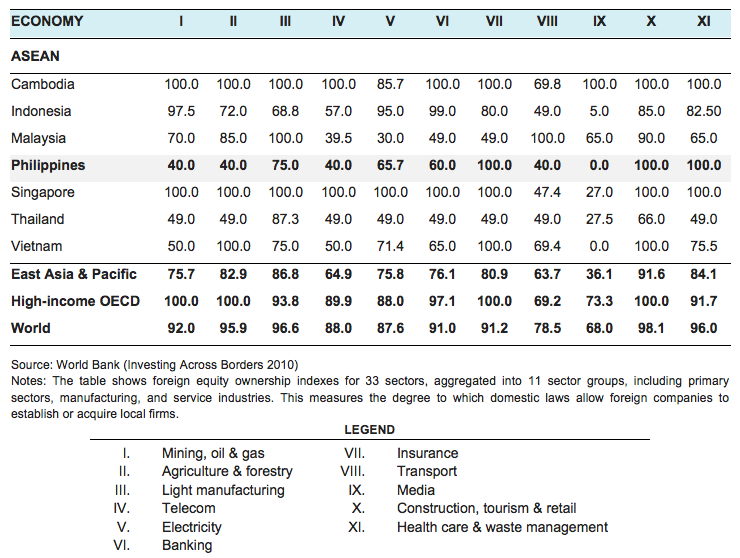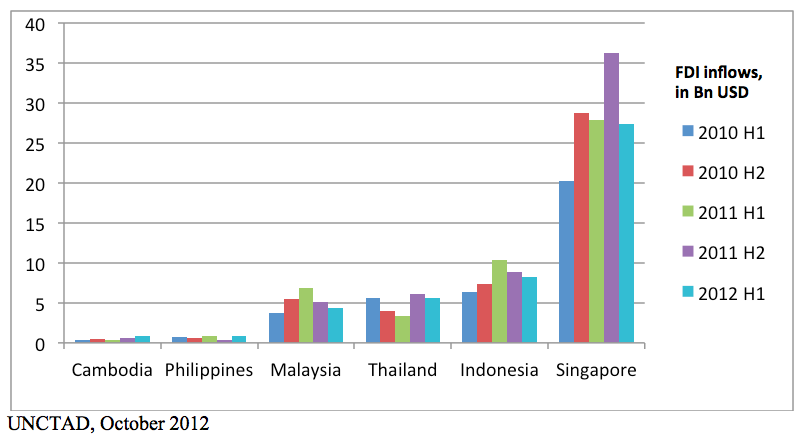JFC Press Release on the 9th FINL (13 November 2012)
November 19, 2012 at 15:07
LET’S MAKE THE FOREIGN INVESTMENT NEGATIVE LIST LESS NEGATIVE
The Philippine Government recently released the 9th Foreign Investment Negative List (FINL) in EO 98 dated October 29, 2012. Contrary to most media reports, the list does not contain new restrictions legislated by the 15th Congress. Rather it adds four new minor restrictions legislated during the 14th Congress in 2007 to 2010.
The Joint Foreign Chambers in the Philippines (JFC) encourage the Philippine Government to be more proactive before the 10th FINL in 2014 to make the FINL less negative. Despite continuous advocacy over almost a decade, responsible public sector leaders have yet to assign priority to shortening the list, with the exception of the economic provisions of the Constitution. Amending these constitutional restrictions has been advocated by Congressional leaders, and a study was reportedly prepared at the request of President Aquino but not publicly released. However, little attention has been paid to removing other restrictions from the list.
During the 20 years since the important liberalizing reform of RA 6957, the Foreign Investments Act (1991) as amended by RA 8170 (1996), only two major changes have been made to the FINL:
- RA 8762, the Retail Trade Liberalization Act (2000) opening retail trade to foreign investors investing at least $2.5 million, and
- EO 158 (2010), the 8th FINL allowing 100% foreign equity in gambling in PEZA zones (by presidential proclamation).
The Philippine economy in 2012 remains more closed to foreign investment that its neighboring large ASEAN economies, according to the World Bank in its Investing Across Borders 2010, which measures how 87 economies facilitate market access and operations of foreign companies.The report presents cross-country indicators analyzing laws, regulations, and practices affecting FDI in investing across sectors.
The report aggregated sectors into 11 industry groups and measured the degree to which domestic laws allow foreign companies to establish or acquire local firms. An index value of 100 indicates that full foreign ownership is allowed. Among the 87 countries surveyed, the Philippines and Thailand have some of the strictestforeign equity rules and fall below the East Asia and Pacific average as well as the High-income OECD economies (see Figure 1).
While constitutional restrictions on foreign capital and foreign professionals are hard to change, restrictions in legislation and/or in interpretations of what should or should not be in the FINL should be easier to liberalize. Restrictions are scattered through various laws, some quite old, and most have rarely been reviewed to determine whether they remain in the national interest, especiallywhether they stand in the way of creating jobs.
The introduction of the FINL was a major reform in 1991, improving transparency for foreign investors with a negative list of business activities foreign investors could not engage in or would be allowed to invest less than 100% equity. Although reissued every two years, the FINL rarely contains any significant reforms, exceptions being retail trade and gambling.Because separate legislation governs the banking sector, restrictions on foreign banks are not listed in the FINL.
A reform policy in government to determine whether existing restrictions continue to be in the national interest is lacking. Year after year, government departments passively apply the same legal restrictions and add new ones when Congress creates them. A review is overdue. This could be done by an inter-agency team instructed to review various restrictions on foreign equity investment in the participation in the Philippine economy of foreign equity, takinginto consideration whether restrictions impede investment, job creation, and competitiveness. A report with specific proposed amendments could be ready by the time the 16th Congress is convened.
One change that would make the FINL less negative that the JFC believes could be made quickly and has advocated for several years.
- Remove the “List A. Practice of all professions” entirely from the FINL because this is not germane in a document that concerning “investment.” There are 46 individual laws that provide for the regulation of as many professions,while the Supreme Court establishes rule for practicing law. All but the laws on professions allow for reciprocity. The Professional Regulatory Commission (PRC) decides whether reciprocity exists when a foreign national applies to practice in the Philippines. The current FINL does not explain this. Furthermore, with some exceptions, there is a distinction between ownership of a company that employs professionals (certified by the PRC) and employees who execute professionalservices. The FINL needs clarification, as it is incorrectly worded in its present form.
As ASEAN moves towards the ASEAN Economic Community there will be more advocacy under the 2007 AEC Blueprint to lower barriers to cross-border investment in priority sectors. Similar challenges may arise if the Philippines negotiates for advanced free trade agreements (FTAs) with the European Union and with the 11 countries currently participating in the future Trans-Pacific Partnership (TPP). The investment chapter of the Korea-US FTA requires unrestricted foreign equity investment between parties, and the same chapter in the TPP is expected to be similar. Parties are given time to transition their laws to meet commitments under the new trade agreements.
Net FDI inflow into the Philippines remains very low compared to five other ASEAN countries in the most recent report of UNCTAD (Figure 2). While many factors explain this situation and there is good reason to expect the amounts to rise in 2013 and thereafter, a Negative List that is too negative is one of the factors effecting FDI that can be further liberalized.
Throughout 2012 we have been encouraged by consistent reports of manufacturing firms of several nationalities relocating from China, Japan, and Thailand because of rising costs, floods, and political risks. Vietnam, Indonesia, and the Philippines – the so-called VIP economies – are being considered by these firms for new and expansion manufacturing investments. The Philippine Government can build on the growing optimism about improved opportunities to invest in the Philippines by making a serious effort to make the Negative List less negative.
JFC Press Release on the Ninth Foreign Investment Negative List (13 November 2012)





























